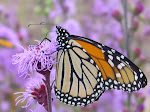Evergreen (conifer) shrubs are often prized by gardeners and landscape designers who use native plants. They "stay green" all season long. In Minnesota, many plants go dormant and lose their leaves of brilliant fall colors during September-October. Then during November-December, most plants offer a subtle variety of brown and tan colors. Finally, Winter becomes a frozen desert of snow punctuated with bare trees and rectangular buildings.
Evergreen shrubs are important plants for foundation of buildings or in gardens as accents, because they provide greenery all season long. Our native evergreen shrubs are useful for natural landscaping because they are not too tall. Many of our attractive (deciduous) native shrubs are tall (6' or taller). However, these three evergreen shrubs can be used closer to buildings and won't block windows.
In Minnesota we have 3 native evergreen shrubs that are conifers. These shrubs are important in another way. These shrubs help songbirds. Common Juniper and Canada Yew provide food (berry-like fruit) and cover for birds during the winter. Creeping Juniper does not provide much cover. However, Creeping Juniper fruit is sought after by Mourning Doves, Rose-breasted Grosbeaks, Blue Jays, Catbirds, Brown Thrashers, Chipping Sparrows and Yellow Warblers. Canada Yew is known to attract Robins and Cedar Waxwings.
 Juniperus communis
Juniperus communis (Common Juniper)
HEIGHT: 3'-5' WIDTH 6'-12'
SOIL: prefers sandy,sandy loam,
average garden soil
NATIVE HABITAT: sandy barrens, abandoned fields and pastures,bedrock outcrops and savannas
LIGHT/SHADE: Full sun; moderately shade tolerant (20-50% shade). Shade is often described as dapple shade from canopy trees.
NATIVE GARDEN USE: full sun prairie gardens, partial shade savanna garden, foundation plantings
CARE: Prune as desired (Mid May-Mid June)
Remove leaves from center of plant. Always sharpen and clean your pruners before pruning your shrubs. 70% isopropyl alcohohol and a paper towel can be used to clean the blades and handles of your pruner thoroughly to prevent the spread of plant diseases.
 Common Juniper
Common Juniper can be used as a foundation plant for along foundations of houses. These shrubs can be pruned to create a more formal appearance. The best time to prune Juniperus communis is during mid-May to mid-June when the plant is developing much of its new growth.
 Juniperus horizontalis
Juniperus horizontalis (Creeping Juniper)
HEIGHT: 6"-9" WIDTH 6'-8'
SOIL: prefers sandy,sandy loam,
average garden soil
NATIVE HABITAT: sandy barrens, abandoned fields and pastures, bedrock outcrops
LIGHT/SHADE: Full sun. Shade intolerant.
NATIVE GARDEN USE: full sun prairie garden, full sun rock outcrop garden, ground cover; plant next to edge of a retaining wall so it will drape over the edge; large planters.
MISCELLANEOUS NOTES: Plant next to short growing grasses or wildflower species. Avoid aggressive short growing native perennials that spread and could shade out this plant.
CARE: Prune as desired (Mid May-Mid June)
Remove leaves from plant. 70% isopropyl alcohohol and a paper towel can be used to clean the blades and handles of your pruner thoroughly to prevent the spread of plant diseases.
 Taxus canadensis
Taxus canadensis (Canada Yew)
HEIGHT: 2'-3' WIDTH 4'-6'
SOIL: prefers loam soils, well-drained humus soils
NATIVE HABITAT: Cool moist forested hillsides; margins for forested swamps. Companion plants are often moss, woodland sedges, Birch spp. and White Cedar
LIGHT/SHADE: partial sun to full shade.
NATIVE GARDEN USE: Massing in woodland gardens; areas shaded by a house; under canopy of trees.
MISCELLANEOUS NOTES: Slow growing. White-tailed Deer browse it often.
CARE: Prune as desired (Mid May-Mid June) 70% isopropyl alcohohol and a paper towel can be used to clean the blades and handles of your pruner thoroughly to prevent the spread of plant diseases.
 Canada Yew
Canada Yew has ascending branches and when massed can have a nice appearance in a woodland garden.
Availability: Common Juniper, Creeping Juniper, and Canada Yew are all available at Out Back Nursery Landscaping in Hastings, MN.



















 ...."natural stones form boundaries of grass there is no need to chop the turf and clip the edge every few weeks."
...."natural stones form boundaries of grass there is no need to chop the turf and clip the edge every few weeks."